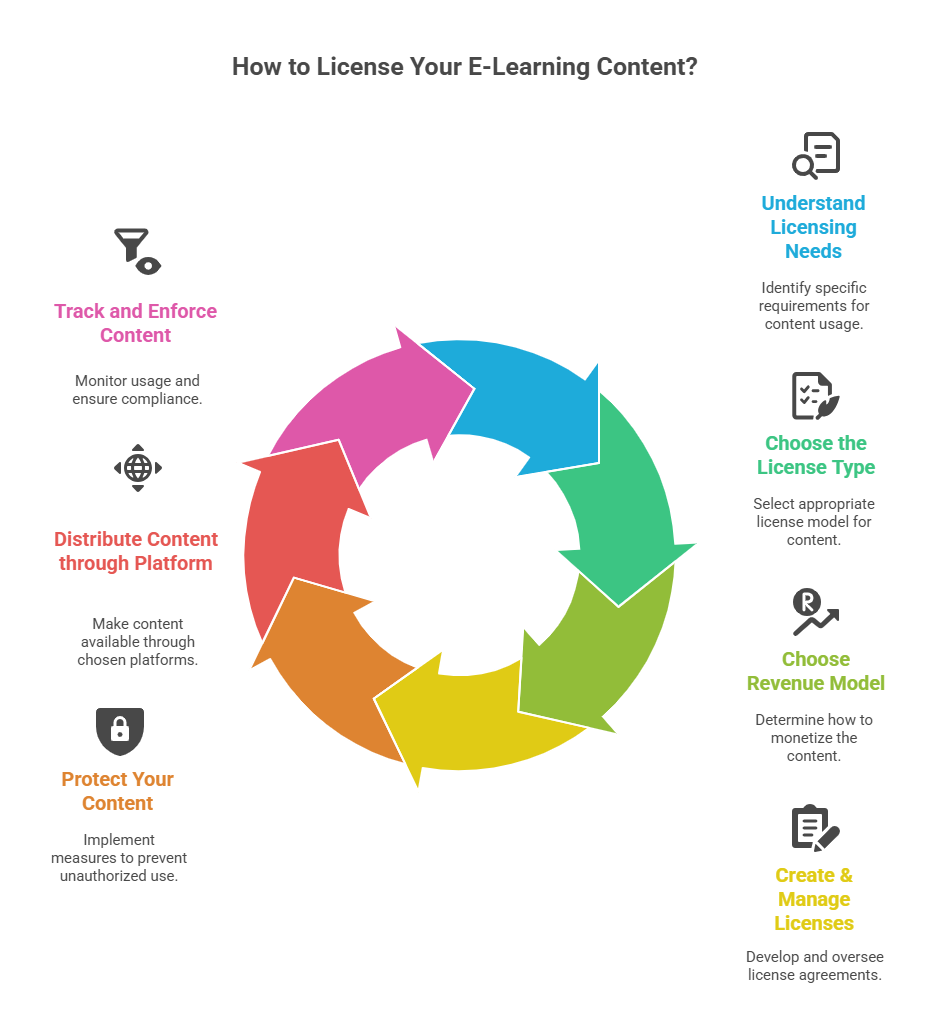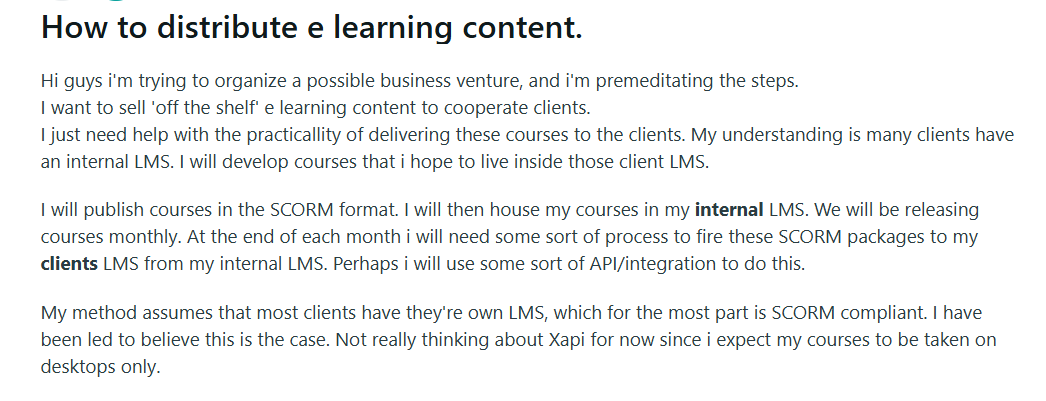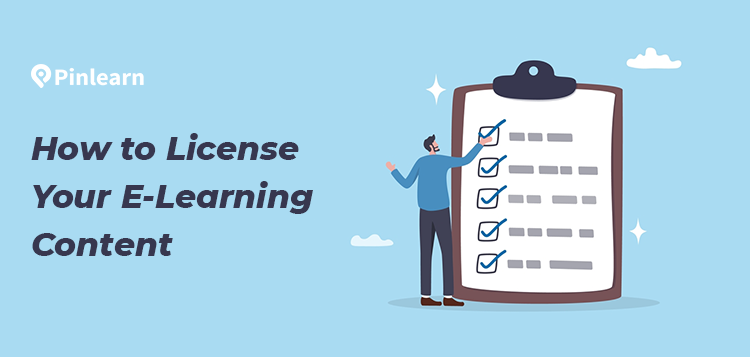How to License Your E-Learning Content: A Quick Guide
Think your course or training videos have the potential to steer the market? There’s good news for you! You can transform your content into a growth machine, amplifying its reach. Content licensing is a powerful tool to churn profits from your content, without transferring ownership.
Be it a strategic corporate partnership or an educational institution collaboration, it proves that all your efforts and time were worthwhile!
So, if you’re new to licensing, this guide makes it easier to learn how to license your e-learning content.
What you’ll learn:
- What is e-learning licensing
- Why license your e-learning content?
- 7 steps to license your e-learning content
So, let’s see how your creation can break barriers and expand your revenue and reach!
What is E-learning Licensing?
E-learning licensing is granting permission to use your content under specific conditions. However, this doesn’t mean transfer of ownership to organizations or people. You will still retain the copyright and IPR of your content. But allow the other party to use, distribute, or modify your content for a fee or for free.
It’s an excellent framework that benefits both parties. It’s a win-win strategy. Creators broaden their reach or earn royalties, while licensees can use the content.
Next, let’s explore why licensing your e-learning content is crucial.
Why License Your E-Learning Content?
Safeguarding your e-learning content is the primary benefit of licensing. It benefits both creators and users to a great extent.
-
Increase Your Audience Reach
With licensing, your creation is accessible to a broad audience. For instance, you’re a creator who sold course content to a corporate or an educational organization. You have just broadened your brand visibility.
-
Cost-Effective
When you have an income from your content, you easily balance the production, marketing, and distribution costs.
-
Generate a Viable Income Stream
Earning royalties or a flat fee from licensing assures you of passive income. Thus, you can earn a recurring subscription revenue, even without transferring your content’s ownership.
-
Saves Time and Resources
Whether it’s a compliance training program or course for your LMS, users don’t need to build from scratch. They can access high-quality content curated by creators. This way, they save time and resources needed for creating the content.
7 Easy Steps to License Your E-learning Content
Whether you’re selling your course to a corporation or on a subscription platform, licensing is crucial.
But, how to license your e-learning content?
Here’s a step-by-step guide on how to license your content the right way:

Step 1: Understanding Your Licensing Needs
Before you formalize that legal contract, first understand your business needs.
Ask yourself: What kind of content are you licensing? Why are you licensing? How much control do you want?
Moreover, each content type might require varying permissions to avoid infringement. For example, you might create a video module to learn Python coding.
Or built an interactive self-improvement course with articles, PDFs, or interactive quizzes.
This helps to understand how to proceed with licensing. Your content might include third-party learning materials. So, make sure you have the permissions to use the content.
Step 2: Choosing the License Type
Now, you have a clear idea of all your e-learning assets. It’s time you choose a licensing type for your e-learning content.
These are the different types of e-learning licenses:
-
Exclusive License
It grants exclusive rights of usage to a single party. Most importantly, the licensor cannot share licenses with other parties during the term. Given that, the license is expensive and involves unique content.
-
Non-exclusive License
In contrast, a non-exclusive license grants rights to multiple parties for content use.
For instance, you have created a cybersecurity awareness course. And sold non-exclusive licenses to five IT firms. While you earn a good income, the company cannot modify or resell it.
-
Custom License
A more professional licensing demands a tailored agreement. This involves defining your own terms and conditions and is used for enterprise deals. A few examples are white label licensing, LMS distribution, or platform bundling.
-
Creative Commons
The next licensing type offers a more open access to content. It offers a free, flexible and easy framework for sharing your e-learning content. But, unlike other licensing types, it offers less revenue and protection. CC BY, CC BY-SA, and CC BY-NC are some common license types.
-
Royalty-based License
This type of licensing helps you earn revenue from your content. The creator decides the revenue based on content usage. On the other hand, the licensee pays once and uses it multiple times.
-
Time-based License
As the name says, it offers time-limited access (like 1-year or 1-month) to the licensee. Once the license expires, it needs to be renewed on a timely basis.
Evaluate your goals, audience, and content preferences before choosing the right licensing type.
Step 3: Choose a Revenue Model
Does your license pay you an ongoing income?
Then, choosing the right revenue structure might hold the key. Enforcing the right revenue model could unlock the secret to a steady platform revenue.
Here are effective revenue models for licensing:
-
Per-User Licensing
Here, the clients pay based on the number of users accessing the software. The revenue scales with the number of clients. This revenue model is common with corporate training.
-
Subscription Model
The subscription model involves the client paying a recurring monthly or annual fee to access the software. Perfect for platforms offering regular, updated content like Saas. The upside is a free flow of income, which helps platform owners to scale their business.
-
One-time Purchase/Perpetual License
This revenue model is quite straightforward. Here, the customers pay an upfront payment for perpetual use. It covers all the features, support, and constant updates in the license.
-
Royalty Model
In the royalty revenue model, the licensee pays the creator to use their content. And generally, the revenue is split on a percentage or sales basis between the creator and the platform.
Step 4: Create & Manage Your E-learning Licenses
The next and important step is — crafting the licensing agreement with key terms. A well-structured license agreement ensures that both parties are protected from infringement.
Key terms to include in the licensing agreement:
-
Licensed Content:
What kind of content are you licensing? Mention the content clearly in the license agreement. This could range from online courses to training videos and ebooks. Also, mention other relevant information, title, author, and copyright information.
-
Usage Rights:
This implies how the licensee can use the content. Define how users can access, use, and share the content, including commercial and non-commercial uses.
-
Ownership:
Define the extent of ownership of the licensor and licensee on the e-learning content. Now, this includes restrictions on usage, sharing, and distribution. Here, the original creator retains the main rights but grants permission for specific usage. Here the creator needs to mention the rights to edit, modify or resell your content.
-
Duration:
Specify the period for which the license is applicable. For instance, this could be for specific months, annual, or even extended for the entire product lifetime.
-
Payment Terms:
Includes royalties, fees, or compensation that the licensee is expected to pay. You also need to cover the payment schedule and conditions involved.
-
Non-Transferable License:
This states the license is not transferable to any other third party. Thus, the ownership cannot be granted to an individual or organisation for training purposes. Even the license cannot be sold, shared, or rented to another entity.
-
Termination:
This section defines the terms or conditions under which the license terminates. Also, include any termination fees or notice periods if applicable.
Consult a legal professional while crafting your license agreement. This ensures you avoid any legal repercussions.
Step 5: Protect Your Content
Even after you license your content, it’s essential to protect it. Safeguarding your content builds trust and prevents unauthorised access to your content.
Here’s how you can protect your online content:
- Register your copyright
- Add a watermark to identify the source of your content
- Employ encryption techniques to control access to your content
- Use Digital Rights Management to control the use, access and distribution of software
- Monitor how your content is accessed with tracking tools
- Enforce the terms of usage for people who use your content online
- For infringement, file a DMCA takedown notice as legal action
Step 6: Distribute Content Through the Platform
The way you distribute your content depends on where your content is hosted. For example, if you are hosting the content on your website or LMS, go for direct licensing.
Alternatively, you could even offer content through third-party platforms. Course marketplaces like Udemy, Coursera, or Saas platforms (Kajabi, Teachable, etc).
Here are some tools for distributing your content:
- Hosted content delivery through Saas platforms
- SCORM/xAPI Licensing through LMS
- API Licensing through SCORM Cloud/ Rustici Dispatch
If your LMS is SCORM-compliant, package your course as SCORM 1.2. Add a licensing agreement for your content. Next, provide the SCORM file once you receive the payment.

Step 7: Track and Enforce Your Content
License agreement breaches can occur despite mentioning all the terms clearly.
Let’s look at two instances of clear license infringement!
When the licensee resells or distributes the content despite being clearly notified. Another instance is when the licensee doesn’t pay royalties they agreed upon.
But, how do you know that the breach has occurred?
Yes, there are tools to track and monitor your e-learning content. If you have hosted your content on cloud-LMS, implement analytics. Keep an eye on content access, completion rates, learner activity, etc.
Alternatively, if clients host your content, use tools like SCORM Cloud. You can easily track content delivery and manage your content. It supports different standards like xAPI and SCORM.
In case of breach, collect relevant evidence and revoke the license access. Further, file a cease-and-desist notice and take appropriate legal action.
Lastly, periodically review your content and convey updates to licensees.
Conclusion
As a creator, your responsibility doesn’t end with content creation. It’s crucial to safeguard your content from lurkers and malicious actors out there.
Licensing is a powerful tool to safeguard your content from infringement. From revenue to reach, licensing touches all the key points of content delivery. Identify the right licensing structure and revenue framework based on your business needs. After all, protecting your content is better than facing legal consequences!
FAQ-Related to How to License Your E-Learning Content
1. How to license your e-learning content?
To license your e-learning content:
- Understand your licensing needs
- Determine your license type (e.g., exclusive, non-exclusive, custom license, royalty-based)
- Choose your revenue model
- Craft your licensing agreement
- Protect your content
- Distribute through the right platform
- Track and enforce your content
2. Do I need to register my content before licensing?
No, it’s not legally required to register your copyright. Though it gives you more legal protection from infringement and data breaches.
3. What happens when someone uses content without a license?
When someone uses content without a license:
- Request a DMCA notice
- Issue a cease-and-desist letter
- Impose a financial penalty, including statutory or actual damages
- Contact a legal professional if you aren’t familiar with legal procedures
4. What to include in an e-learning license agreement?
Include the following key terms in your license agreement:
- Licensed content
- Ownership
- Payment Terms
- Usage Rights
- License Duration
- Termination
- Non-Transferable License
- Modification and Resale Rights





